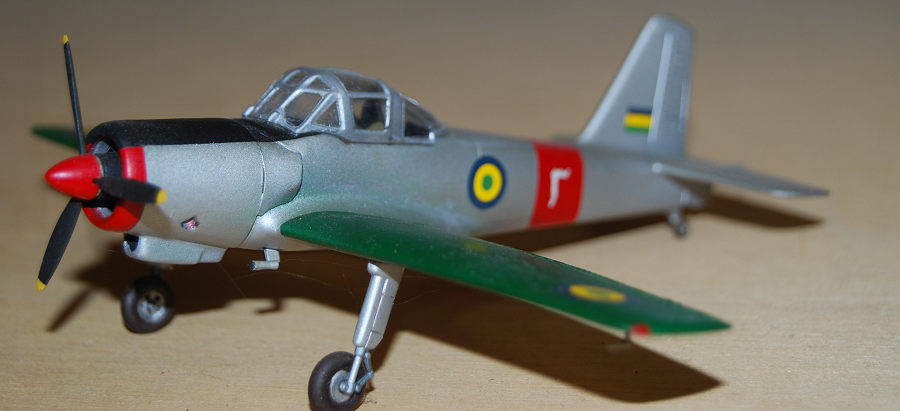
Matchbox 1/72 Provost
| KIT #: | PK-30 |
| PRICE: | $5.00 'used' |
| DECALS: | Two options |
| REVIEWER: | Christopher Campbell |
| NOTES: | Simple kit, fun and easy to build. |

| HISTORY |
The Percival Provost was a simple, rugged, two seat trainer developed for the British Royal Air Force during 1950. It would feature side by side seating, much as the Cessna T-37, though in a prop driven format. This enabled the instructor to have a more direct input with the student pilot. It was a rugged and simple design featuring fixed landing gear and three-blade propeller driven by the nine-cylinder, Alvis Leonides 25 air cooled radial. Producing 440 horsepower.
This would be the last reciprocating piston engine powered trainer to enter service with the R.A.F., replacing the Percival Prentice, an aircraft of similar fixed gear design which had a relatively short service of only six or seven years. First flying in 1950, it would enter service with the R.A.F. and remain there until the last were withdrawn in 1969, most having been replaced by B.A.C. Jet Provost trainers.
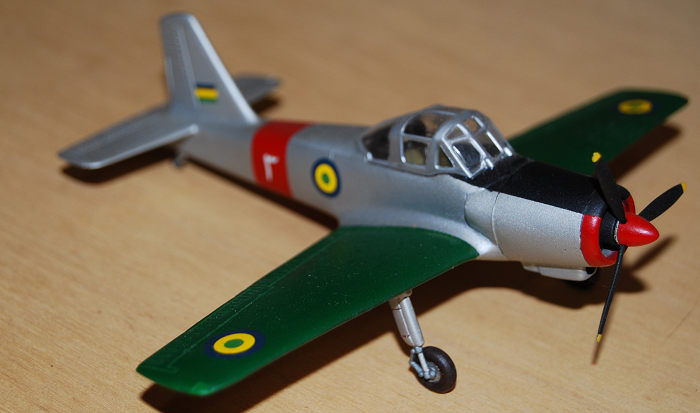 It was a successful design, being easy to handle and
ideal for basic flight instruction. Its cockpit offered excellent visibility,
Retracting amber screens were incorporated which allowed students to practice
instrument flying during the daytime when wearing special tinted goggles to
simulate night or bad weather conditions. This was combined with high frequency
VHF radio euqiment allowing for GCA landings in conditions of poor visibility.
This was something new in an R.A.F. primary trainer, though appropriate as such
equipment was becoming effectively standard on aircraft then entering service.
It was a successful design, being easy to handle and
ideal for basic flight instruction. Its cockpit offered excellent visibility,
Retracting amber screens were incorporated which allowed students to practice
instrument flying during the daytime when wearing special tinted goggles to
simulate night or bad weather conditions. This was combined with high frequency
VHF radio euqiment allowing for GCA landings in conditions of poor visibility.
This was something new in an R.A.F. primary trainer, though appropriate as such
equipment was becoming effectively standard on aircraft then entering service.
The Provost would see service with export customers, principally in nations that were former Colonial holdings. The first would go to Rhodesia in 1953. Subsequent orders came from Burma, Iraq, Ireland, Malaysia, Oman, and Sudan. Some would be fitted with simple armament packs to serve in a counterinsurgency role.
All are now withdrawn from active service, though many are preserved in museums. Many of these are airworthy and fly as warbirds or in historic flights. Given the simplicity of the type, it is likely that they will continue to do so for some years to come.
| THE KIT |
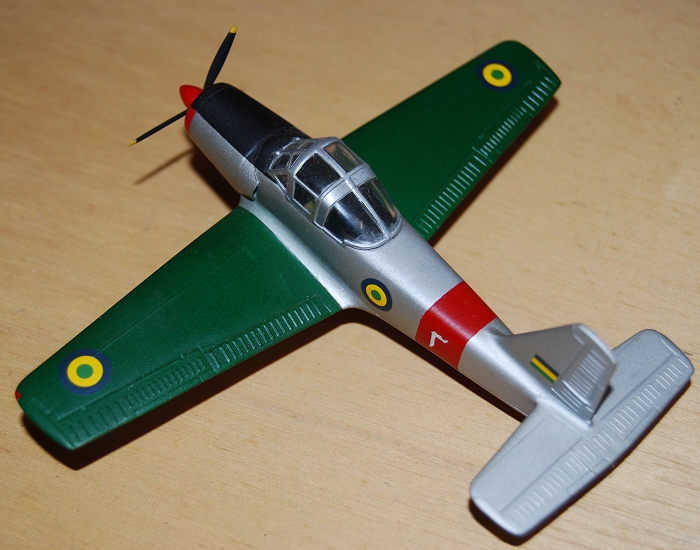 First released by Matchbox in 1976, this is a simple
kit typical of its era. It is molded in red and white plastic and features
raised detail. The detail does not look overdone and seems to “fit,” as it were,
when one looks at photos of the actual aircraft.
First released by Matchbox in 1976, this is a simple
kit typical of its era. It is molded in red and white plastic and features
raised detail. The detail does not look overdone and seems to “fit,” as it were,
when one looks at photos of the actual aircraft.
The engine is molded into the firewall and cockpit is very simple, mainly being a tub with seats. Overall, if you have seen Matchbox kits of this era, there are no surprises. It is very simple with a low parts count and adequate for what is being rendered.
Kit decals offer the option of building either a British or an Omani aircraft. The only thing that I would fault the kit for is the propeller being molded along with the spinner. This in an of itself is not a problem. However, the blades are bit on the flimsy side and can be damaged easily.
| CONSTRUCTION |
I had seen this kit before over the years, though had never really paid that much attention to it. I do like trainers, however, as they often allow for very colorful aircraft. I purchased this one on a whim from a vendor at my local I.P.M.S. show around 2007.
This particular seller was liquidating a large collection, which I believe may have belonged to her spouse. While there were kits from many manufacturers, he must have had fondness for Matchbox, as there were numerous examples of every 1/72 kit that they had released. I do not believe that I have ever before or since seen such an aggregation Matchbox kits in one place.
Despite their shortcomings, I will admit to having a soft spot for Matchbox to a certain degree. They offered some very unique subjects in their day, many of which were the only available kits of some aircraft at the time. Until fairly recently, that was the case with the Provost. I believe that their Fairey Seafox and BAC Lighting T.55 are still the only injection molded offerings to date.
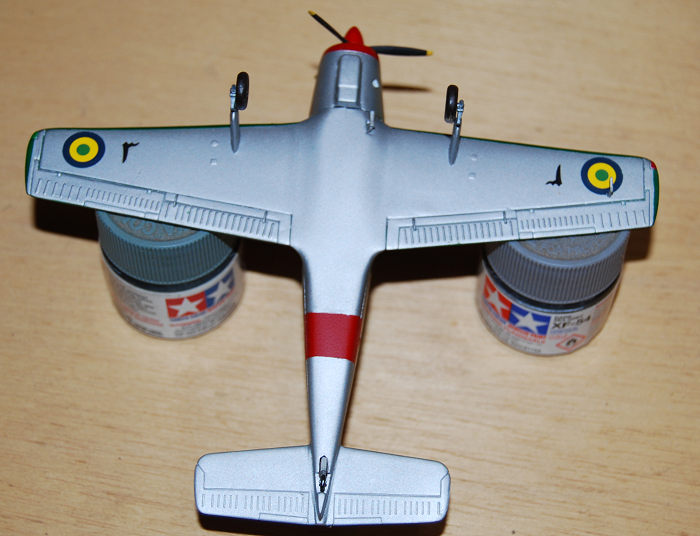 It sat in my stash for a year or two until I happened
upon the subject that I wanted to build. Then I was looking through
Squadron/Signals book number 6066, Arab Air Forces by Charles Stafrace and saw
the illustration of a Sudanese Provost. I realized that I had some of these
early Sudanese roundels in my decal stash and I finally had a subject to use
them on.
It sat in my stash for a year or two until I happened
upon the subject that I wanted to build. Then I was looking through
Squadron/Signals book number 6066, Arab Air Forces by Charles Stafrace and saw
the illustration of a Sudanese Provost. I realized that I had some of these
early Sudanese roundels in my decal stash and I finally had a subject to use
them on.
As mentioned, it is a very simple kit. I started by spraying the interior in Tamiya Flat Black as well as the cockpit tub, engine, and firewall. The interior of the cowl halves were painted in Testors Flat Grey and set aside. Then the engine cylinders were drybrushed with Model Master Dark Anodonic Grey, Testors Silver, and Flat Grey.
The cockpit detail is sparse, as was typical of most 1/72 offerings of the era. Very little can be seen through the thick canopy, however. I painted the seats in Model Master Middlestone and gave them a light wash. The instruments were picked out by drybrushing with Testors Silver with a few spots of yellow, red, and green added to imply various indicator lights and switches.
Once this had dried, the cockpit was mated to the fuselage and the two halves were glued up with thick CA glue. This effectively sealed any would be gaps and required only some sanding with 320 & 400 grit sandpaper followed by polishing with 0000 steel wool. The wings were glued together as well with any remaining seams cleaned up in the same manner. These were then installed in the slots on either side of the fuselage.
This was a bit more gappy than anything else thus far. The joint was given a thin application of Squadron Putty, smoothed with a Q-tip soaked in nail polish remover and left to dry. This was then sanded lightly and any pits or flaws were sealed with thin CA applied with a toothpick and sanded until smooth.
The horizontal tail is a single piece and there is a gap once it is installed. This was dealt with in the same manner as the wing joint and proved easy to clean up. The cowl and engine assembly was glued up and required a bit of sanding, mainly around the cowl ring. Still, there were no unexpected surprises and it was soon glued to the nose. After rubbing everything down several times in dryer sheet to rub out any remaining scratches I deemed it ready to paint.
| COLORS & MARKINGS |
As usual, the cowl and cockpit were stuffed with damp bits of paper towel to protect for any overspray. The red cowl ring and fuselage band were first painted using Testors Flat Red. Once dry, this was masked off with Tamiya tape and the anti-glare panel painted in Testors Flat Black along with the propeller. While this was drying, the propeller spinner was hand painted in more Flat Red with yellow tips being added to the props. Once this was dry enough, more Tamiya tape was used to mask off the Anti-Glar panel. Now to the wings.
The few illustrations that I have seen of the Sudanese aircraft seem to show a very bright green used on the upper surface of the wings. Looking over the paints that I had on hand, Testors Gloss Green looked to be the closest match. A drop of Flat Black was added to tone it down slightly. This was then sprayed on the wings and set aside to dry.
The wings were masked off. Then landing gear legs were then glued into place along with the tail wheel. Then everything was sprayed in Model Master Aluminum. Despite some slightly complicated masking, given the scale, it was actually quite an easy painting session. Once I was satisfied that it had dried sufficiently the masks were removed and it was given a coat of rattle can Model Master Clear Gloss.
Now for the fun part, or not so fun. I mentioned that I had the old style Sudanese roundels in my decal files. I did, though from a dubious source. These were on an old ESCI sheet that I believe dates to the late 1970’s. They produced many decal sheets featuring roundels and insignia of nations rarely seen then or now. I still have quite a few and manage to use them from time to time, though not without difficulty.
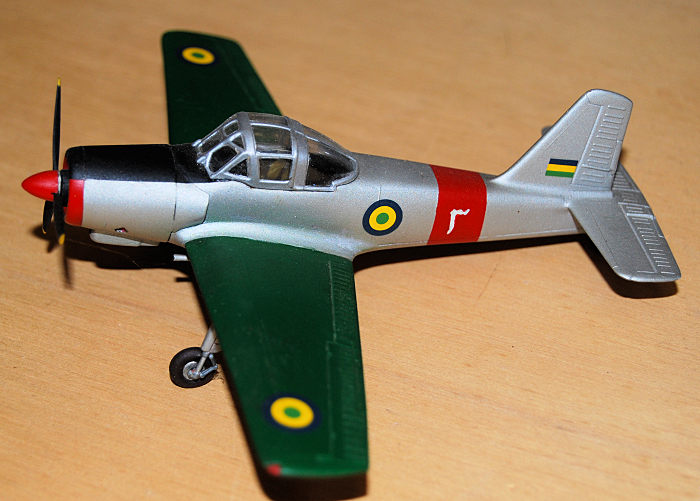 While these worked well enough when new, or even a
decade old, almost all that I have seen or attempted to use since the late
1990’s have shown that they do not age like wine. They now tend to be very prone
to cracking if you even look at them. On the rare occasions that this does not
happen, they either tend to curl or simply refuse to adhere.
While these worked well enough when new, or even a
decade old, almost all that I have seen or attempted to use since the late
1990’s have shown that they do not age like wine. They now tend to be very prone
to cracking if you even look at them. On the rare occasions that this does not
happen, they either tend to curl or simply refuse to adhere.
I have dealt with this in a number of ways over the years. In this case, I applied some Microscale liquid decal film over the ones that I wished to use. This was followed by a light shot of Testors Decal Bonder Spray. It is no exaggeration to say that each time they are used it is something of an experiment, as they do not always respond the same way to the treatment used.
As previously mentioned, adherence is a problem with them as well. This usually necessitates a somewhat harsh setting fluid such as Solvaset, which as often as not counteracts what has already been done to keep them intact. (In one almost surreal session where adherence was utterly nonexistent, I resorted to brushing the back of the decal with Elmer’s School Glue diluted with MicroSol. To my surprise, it actually worked, not that I want to try it again.)
In this case, a small amount of Solvaset applied to the surface before the decals did the job. I think that this is the only time that in the past twenty years that I have only used the six roundels and tail flash as planned without any coming apart.
The Arabic numeral three in black on the underside of the wings came from one of a number of fragmentary sheets in my Middle East decal folder where I have squirreled away decals featuring the numerals every chance that I get. This was in fine condition and went on with no trouble.
The white numeral on the red fuselage band was a different matter, though. I had no Arabic numeral decals in white at all. I thus did my best to letter it by hand using Model Master Flat White and a fine brush. It is not perfect, though looks good on the shelf. While I was at it, I added the wingtip light from Testors Gloss Green and Gloss Red. Satisfied that things had cured enough, everything was then given a shot of Model Master Dullcoat.
| FINAL BITS |
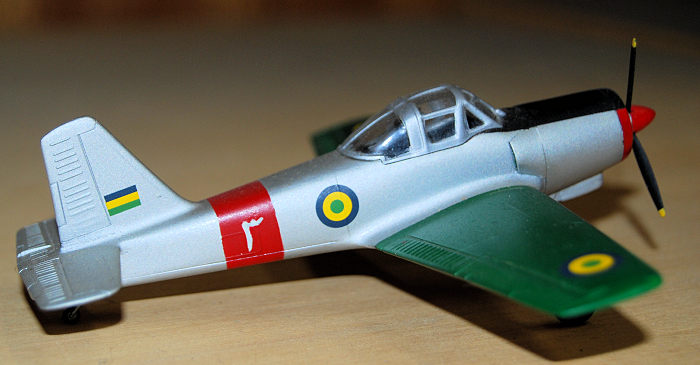 There was very little remaining to be done at this
point. The wheels were painted Testors Aluminum and the tires in Testors Rubber.
Once dry they were glued in place. Then the pitot, exhaust sub, and venturi were
painted and added (Note: It was only upon reviewing photos of this model for
this article did I realize that the exhaust pipe stub has now migrated
somewhere. Something from the spares box will be scrounged and fitted
accordingly.) The propeller was now glued in place, leaving only the canopy to
complete the build.
There was very little remaining to be done at this
point. The wheels were painted Testors Aluminum and the tires in Testors Rubber.
Once dry they were glued in place. Then the pitot, exhaust sub, and venturi were
painted and added (Note: It was only upon reviewing photos of this model for
this article did I realize that the exhaust pipe stub has now migrated
somewhere. Something from the spares box will be scrounged and fitted
accordingly.) The propeller was now glued in place, leaving only the canopy to
complete the build.
Canopy framing was painted by hand in Model Master Aluminum. Tiny windscreen wipers are molded into it which were picked out in Testors Rubber. When dry, this was given a light coat of Future and glued in place using CA glue.
Now it was finished. I had a diminutive, though lovely and colorful model of an aircraft in most unique insignia. I find these early Sudanese roundels to be some of the most attractive insignia that I have seen, with their blue-yellow-green being most distinctive and colorful. It makes for a nice shelf mate for a buildup of the same kit that my uncle, Richard Cobb gifted to me in the kit supplied Omani markings.
| CONCLUSIONS |
Yes, it is a Matchbox kit, both for good and for bad. It is a very easy kit to assemble with a minimum of fuss. Is it sorely lacking of detail by today’s standards? Yes. Does it still build up into a very nice representation of the Provost? Yes, again.
I would recommend this kit to anyone who wants a Provost in their collection. It also would be a nice kit for beginning modeler, to be enjoyed with one’s child or grandchild and introduce one to the pleasures of model building. Also, there is quite a variety of potential paint schemes that could be chosen, most of them rather colorful in one way or another.
There are newer tool kits from MikroMir and S & M Models, the former quite new. I have not seen either, though suspect that they are superior to the Matchbox kit in detail. I doubt that they are as easy to build though. This was one of the quickest builds that I have done in years. I completed it over the course of a single weekend, starting on Friday night and finished by Sunday afternoon. If I had to guess, I would say that my actual working time was a maximum of six hours.
I will doubtless build another at some point, likely is Malaysian markings, as I enjoy modeling aircraft in somewhat less frequently seen insignia. There is also a newer release 1/48 kit from MikroMir that I plan to build up in Irish colors. Of course, I really should do one in British markings as well at some point. Like many trainers, I simply find it a lovely little aircraft. I only wish I could afford own and operate a real one.
Is this kit or my build perfect? No. Does it look good one the shelf? Definitely. I have taken it several shows mainly just to show it off and have people ask what country it depicts. It always gets a lot of attention. Most of all, it was fun and satisfying to build, thusly making it a favorite piece in my collection.
| REFERENCES |
Arab Air Forces by Charles Stafrace, Squadron/Signal Publications # 6066, 1994
The Encyclopedia British Military Aircraft by Chaz Bowyer, Crescent Books, 1982
https://en.wikipedia.org/wiki/Percival_Provost
21 October 2024
Copyright ModelingMadness.com. All rights reserved. No
reproduction in part or in whole without express permission.
If you would like your product reviewed fairly and fairly
quickly, please
contact
the editor
or see other details in the
Note to
Contributors.